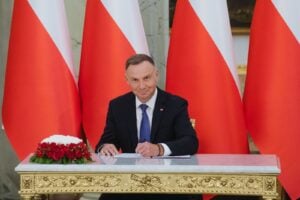Medvedev threatens NATO with war if the EU creates a no-fly zone over Ukraine
15 September 15:28
In a statement on Telegram, Russian Security Council Chairman Dmitry Medvedev warned that if NATO countries start shooting down Russian drones over Ukraine or in its airspace, Moscow will consider it the beginning of a war with the Alliance, "Komersant Ukrainian" reports.
This comes amid recent cases of Russian drones violating the airspace of Poland and other NATO countries and proposals by some European politicians to consider interception or defense options over Ukraine.
What Medvedev said specifically
In a post on Telegram, Medvedev called the idea of creating a “no-fly zone” or allowing NATO countries to shoot down Russian drones “provocative” and warned that such actions “would mean a war between NATO and Russia.” He also threatened to prosecute EU countries in court if they start using frozen Russian assets as a “loan” to Ukraine. The text and tone of the statement coincide with Medvedev’s previous harsh statements about NATO.
Why it happened now
- Incidents with drones in NATO airspace. In August-September, several Russian drones crossed the borders of NATO countries (including Poland and Romania), forcing the alliance to step up patrols on its eastern flank and, in some cases, to act to repel the threat. This has prompted some European politicians, including the Polish foreign minister, to talk about drone interception and “protection” over Ukraine.
- Discussion about a “no-fly zone”. The idea of introducing some kind of airspace protection regime over Ukraine or allowing allies to strike Russian targets “on the fly” is being discussed openly-but with great resistance in key capitals because of the risk of direct confrontation with Moscow.
The legal and military side: what does it mean to “shoot down over Ukraine”?
- If NATO fighter jets shoot down a Russian drone over the territory of sovereign Ukraine, this does not technically mean that NATO Article 5 (collective defense) is automatically invoked, as it applies to attacks against allies. However, Moscow could interpret such actions as direct interference and respond in its own way, making the threat potentially very dangerous.
- In practice, interception/destruction of UAVs often occurs on approach to the target or after crossing the border; the difference in where and by whom the strike is carried out is key to the diplomatic interpretation of the event.
Possible scenarios – from escalation to containment
- “Localized incident” scenario – NATO/partners intercept a drone in international or allied airspace; the Kremlin protests diplomatically, but escalation is avoided
- “ Gentleescalation” scenario – a few incidents, shootings or damage to allied assets; Moscow responds with cyber attacks, strikes on logistics, possible demonstration of force on NATO borders.
- The “sharp confrontation” scenario – if Moscow considers the Alliance’s actions to be systemic, it may respond militarily (for example, by striking military targets near the border or in areas that Moscow considers to be involved). This is the risk of a direct clash that all parties are trying to avoid.
What experts say – assessment of chances and risks
- Analysts from strategic centers warn that Medvedev’s rhetoric is noticeably escalated, but it is also aimed at political pressure and demoralization of the enemy; it is not clear that it reflects the Kremlin’s immediate plans to launch a large-scale war against NATO.
- Military experts point out that it is technically possible to shoot down drones over Ukraine with the participation of third countries, but it requires clear rules of engagement and coordination to avoid “an incident that gets out of control.”
What to expect in the near future
- NATO will continue to increase its readiness on the eastern flank and coordinate with its allies.
- Diplomatic consultations between key capitals will intensify, along with new political statements and warnings from both sides.
- The risk of an “unforeseen incident” remains the highest, whether by accident, technical failure, or deliberate provocation.
Medvedev’s threats are serious and increase tensions, but so far they are primarily a political and informational tool of the Kremlin. A real transition to an open conflict between Russia and NATO will require a number of additional steps and, most likely, a broader consensus in Moscow. In the meantime, the risks of mistakes, incidents, and unwanted escalation remain high, and this is what the allies’ diplomacy and military planning should focus on.









